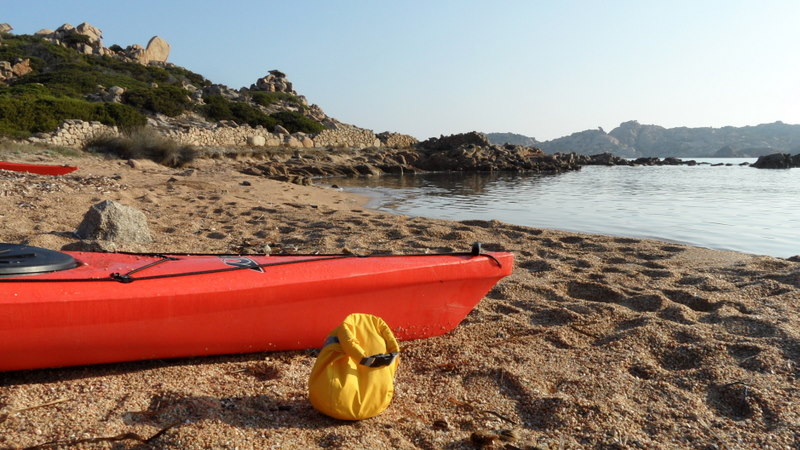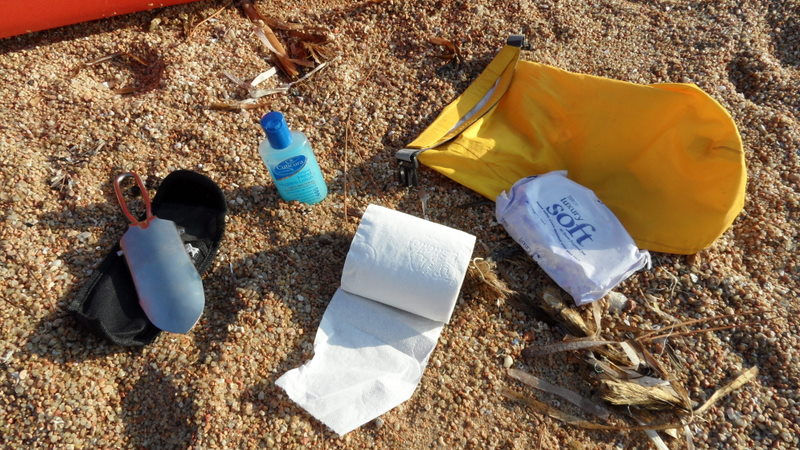Whether you’re planning on ‘changing your shoes’ or ‘taking your trowel for a walk’ there’s no getting away from that call of nature when you’re out in the back of beyond on a paddling expedition – no matter what you call it. Admittedly those are two of the more polite terms we’ve had knocking around Chelsea Kayak Club in the past few years whenever we’ve been on extended wild camping tours – but when it comes to the crunch, there are no toilets on these barren coastlines so you’re basically pooing in a hole behind a bush somewhere!
This probably isn’t the blog you want to read whilst eating breakfast, but I thought it would be educational for many a paddler anyway, so here goes, the CKC guide to shitting in the woods*:
- Get yourself an easily identifiable dry bag, which is exclusive for this purpose, for your essential hygiene kit (toilet tissue, water-free hand sanitizer and wet-wipes) – small and bright would be my suggestion, so that it can pack into a day hatch easily and can be seen better when you’re fumbling around your tent in the middle of the night.
- A tough yet compact and light trowel should be either in or connected to the bag. It’s customary to bury your business, so as not to spoil the local scenery (and to aid decomposition), so a trowel for digging your initial hole in dry, rocky soil is preferable to using your hands.
- Keep it clean – the last thing anyone wants to do is carry kit that smells of you know what, so, when you’re done squatting; fill the hole back in using the excavated debris. Note that your trowel doesn’t actually ever come into contact with any poo.
- Mark your loo spot. You’ll be out with other paddlers who, like you don’t have the luxury of a tiled bathroom or ceramic toilet to sit and do the crossword on, therefore if you’ve already found a nice, discreet spot with a stunning view – chances are they’ll be heading in the same general area too, and nobody wants to be digging up what you left behind! The standard ‘good practice’ is to stick a twig into the ground where you’ve been, so that it stands out like a little flag pole, failing that, pile a few stones/rocks on to each other.
I’m sure that there’s lots of science behind exactly where you should go (above/below the water line) and how deep you should dig – but it really all comes down to how desperate you are doesn’t it? Remember that we’re there to enjoy the environment, landscape and scenery – not to spoil it for others, so keep waste to a minimum and be considerate of those who will visit in the future.
*There’s actually a lot of thought that’s gone into the official guide to defecating in the wild, but ours is more real – and what actually happens.
John




John
sorry mate but you forgot to add the most important bit: – that the ‘site’ of your article’s activity must be below the high water mark.
Here is some info from an article Mark Rainsley : –
Where’s the loo? Do your business well away from camp, between the high and low tide mark. Burn paper and bury everything. Some paddlers carry out all waste in tubes. Alternatively, wait for or walk to a public toilet
++
or below from Douglas Wilcox’s excellent article on organising a camping trip which also covers the issue of camp fires that Chelsea Kayak CLub has to address when in Scotland (ie: We should always try to build a fire on the beach, preferably below the high water mark.)
Where to “go”
It is best to urinate below high water mark on the
beach. If you need a pee during the night, make an effort
to go to the beach; don’t pee just beside the tent. The
next camper may be preparing food on that spot. To
avoid a night time excursion, males can use an old
plastic milk bottle in the tent at night. Females can
purchase a custom device such as a TravelMate. In the
morning dispose of the urine below high water mark,
never on land near running water.
As sea kayakers it is usually best to defecate below
high water mark. Walk well away from the landing beach
and find a secluded spot in the rocks. Wrap your toilet
tissue up tightly. Some wet tissues are antiseptic and
good for washing hands afterwards but beware of dirt
under your nails. Put the tissues in a food grade poly bag
with a ziplock. Either pack it out or burn it in your fire
later. The same goes for female sanitary products. If
you are camping at the head of a long sea loch, there
may be little tidal movement and it may be preferable to
bury faeces. Find a spot at least 50 meters away from
running water and dig a small hole with a trowel about
15 cm deep. Do your stuff then infill the hole carefully
replacing any surface turf.
If your bowel habit allows, it is probably best to go
after preparing a meal and eating, to minimise the risk of
stomach upsets.
That’s really interesting, thanks John and Richard. I haven’t heard advice before about “changing your shoes” below the high water mark, only about where to bury said deposit. Does he really advocate going in the sea?!
Or does he just mean leave it lying on the beach below the high water mark in a tidal area? I think the fact that two of my recent trips have been in the Mediterranean has confused the issue as there is minimal tidal movement there.
I have to say all the advice I have heard has been to dig a hole 15cm deep, well away from the beach, deposit in the hole and use the trowel to fill in the whole with earth again. And don’t take the mickey out of those who bring a full on metal garden trowel with them on a trip until you have experienced futile digging in hard soil with a flimsy plastic trowel while in a hurry!
I am heartened to hear that Mr Wilcox advises wrapping up tissue and burning it or disposing of it in a ziplock bag and placing it in your rubbish as despite the concept of biodegradability it is undesirable to see used toilet paper fluttering away on on the breeze if an accidental excavation occurs!
How to Shit in the Woods is a great book on this subject.
The author, Kathleen Meyer, is N American and she uses humour to convey some essential information. She starts with a claim I found startling – that there’s nowhere on the N American continent where you can drink running water and be sure it’s free of waterborne parasites (girardia, if memory serves me right).
She also describes the stringent conditions that require kayakers and rafters running the Grand Canyon to carry out all their poo.
But the bit that made me chuckle was her description of frosting, a process much like frosting a cake that the encourages UV to break down faeces. Whoever would have thought of that?